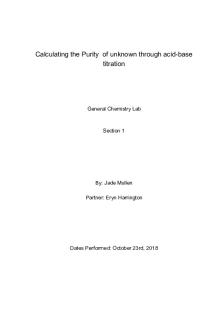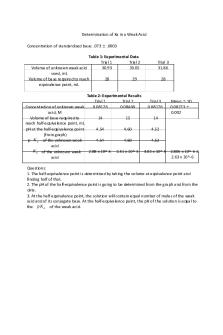TWA Lab Summary - Titration of a weak acid PDF

| Title | TWA Lab Summary - Titration of a weak acid |
|---|---|
| Author | Anthony Mba |
| Course | General Chemistry 233 |
| Institution | Oregon State University |
| Pages | 3 |
| File Size | 185.7 KB |
| File Type | |
| Total Downloads | 442 |
| Total Views | 975 |
Summary
Lauren Murphy Anthony Mba Emma Maddox CH 263, Section 21, Group 5 TWA Lab Summary Summary Questions 1) The concentration for phosphoric acid in our experiment was 0 H 3PO4 mol M= L mol 0 NaOH= 0 L NaOH mol=0 NaOH 0 mol H 3 PO 4 M= 0 L M= 0 M H3PO4 2) The Ka1 and Ka2 for phosphoric acid in our group ...
Description
Lauren Murphy Anthony Mba Emma Maddox CH 263, Section 21, Group 5
TWA Lab Summary Summary Questions
1) The concentration for phosphoric acid in our experiment was 0.088M H3PO4 mol M= L mol 0.1109M NaOH= 0.02 L NaOH mol=0.00218 NaOH 0.00218mol H 3 PO 4 M= 0.025 L M= 0.088 M H3PO4 2) The Ka1 and Ka2 for phosphoric acid in our group was 0.0245, and 1.44x10-9 respectively. 3) Literature values for Ka1 and Ka2: 7.5x10-3 and 6.2x10-8. The percent error value for Ka1 is 226% error and for Ka2 it is 97% error. 4) A value for Ka3 could not be determined because after the second equilibrium point all of the H3PO4 is consumed, and we wouldn’t get another equilibrium point on the graph for us to calculate Ka3. 5) (34−19.5 )mL (0.1109) M =0.064 M H 3 PO 4 25 mL 19.5−(34−19.5)mL(0.1109)M 6) =0.0222 M HCl 25 mL Summary of Experimental Procedures:
To begin the pH meter was connected to the computer and logger pro was turned on. Then “Chemistry with vinier” and “24a titrate acid and base” were opened. The pH meter was calibrated in a pH 7.0 buffer and a pH 4.0 buffer by placing it in each solution for 30 seconds. Obtained 25 mL of H3PO4 put it into a 150 mL beaker with a stir rod and then it was placed on the stir plate. The burette was filled with NaOH. Then the pH meter was placed into the H3PO4 solution and the stir plate was turned on. The solution was titrated in 1 mL increments until 17 mL, while data points for each mL were collected. After 17 mL, the solution was titrated in 0.5 mL increments to the first equilibrium point (about 22mL). The method of titration previously used was repeated until 37 mL were titrated, and 0.5 mL to second equilibrium point. The titration was used again 1 mL increments to 55 mL to finish titrating. Next, the titration of the mixture of
HCl and H3PO4 (25 mL) was performed using the exact same method as the previous titration. The data was recorded and saved on logger pro. Finally, the concentration and Ka values were calculated for H3PO4 in the first titration and the concentration of HCl and H3PO4 were calculated for the second titration. The materials were cleaned and waste was disposed of. Specific Results
First titration using NaOH and H3PO4
Second titration using NaOH and mixture of H3PO4/HCl
H3PO4 titration Concentration: .088 M Ka1: 0.0245 Ka2: 1.44x10-9 H3PO4 and HCl titration H3PO4 concentration: 0.064 M HCl concentration: 0.0222 M
Brief Conclusions The titration using NaOH and H3PO4 resulted in the findings of the concentration of H3PO4 . The concentration calculated was .088 M by using the pH graph’s equilibrium points and the volume of NaOH used to titrate. The concentration was then used to calculate the two Ka values for each equivalence point. The second titrations data was used to calculate the concentration of the H3PO4 and HCl. The volumes of NaOH used to titrate between equilibrium points were used to determine these concentrations. In conclusion, titrations, and pH meter data allows the concentrations and Ka values to be determined. Ka values represent acid dissociation for H3PO4 in this experiment. The Ka1 value was 2.45E-2 which resulted in a 226% error and Ka2 was 1.44E-9 and a 97% percent error....
Similar Free PDFs

Titration of a Diprotic Acid
- 7 Pages

Amino Acid Titration Lab
- 2 Pages

Acid base titration lab report
- 5 Pages

Acid-Base Titration Lab Report
- 7 Pages

Acid-Base Titration Pre-Lab
- 4 Pages

Acid Base Titration
- 7 Pages

Acid Base Titration
- 15 Pages
Popular Institutions
- Tinajero National High School - Annex
- Politeknik Caltex Riau
- Yokohama City University
- SGT University
- University of Al-Qadisiyah
- Divine Word College of Vigan
- Techniek College Rotterdam
- Universidade de Santiago
- Universiti Teknologi MARA Cawangan Johor Kampus Pasir Gudang
- Poltekkes Kemenkes Yogyakarta
- Baguio City National High School
- Colegio san marcos
- preparatoria uno
- Centro de Bachillerato Tecnológico Industrial y de Servicios No. 107
- Dalian Maritime University
- Quang Trung Secondary School
- Colegio Tecnológico en Informática
- Corporación Regional de Educación Superior
- Grupo CEDVA
- Dar Al Uloom University
- Centro de Estudios Preuniversitarios de la Universidad Nacional de Ingeniería
- 上智大学
- Aakash International School, Nuna Majara
- San Felipe Neri Catholic School
- Kang Chiao International School - New Taipei City
- Misamis Occidental National High School
- Institución Educativa Escuela Normal Juan Ladrilleros
- Kolehiyo ng Pantukan
- Batanes State College
- Instituto Continental
- Sekolah Menengah Kejuruan Kesehatan Kaltara (Tarakan)
- Colegio de La Inmaculada Concepcion - Cebu








